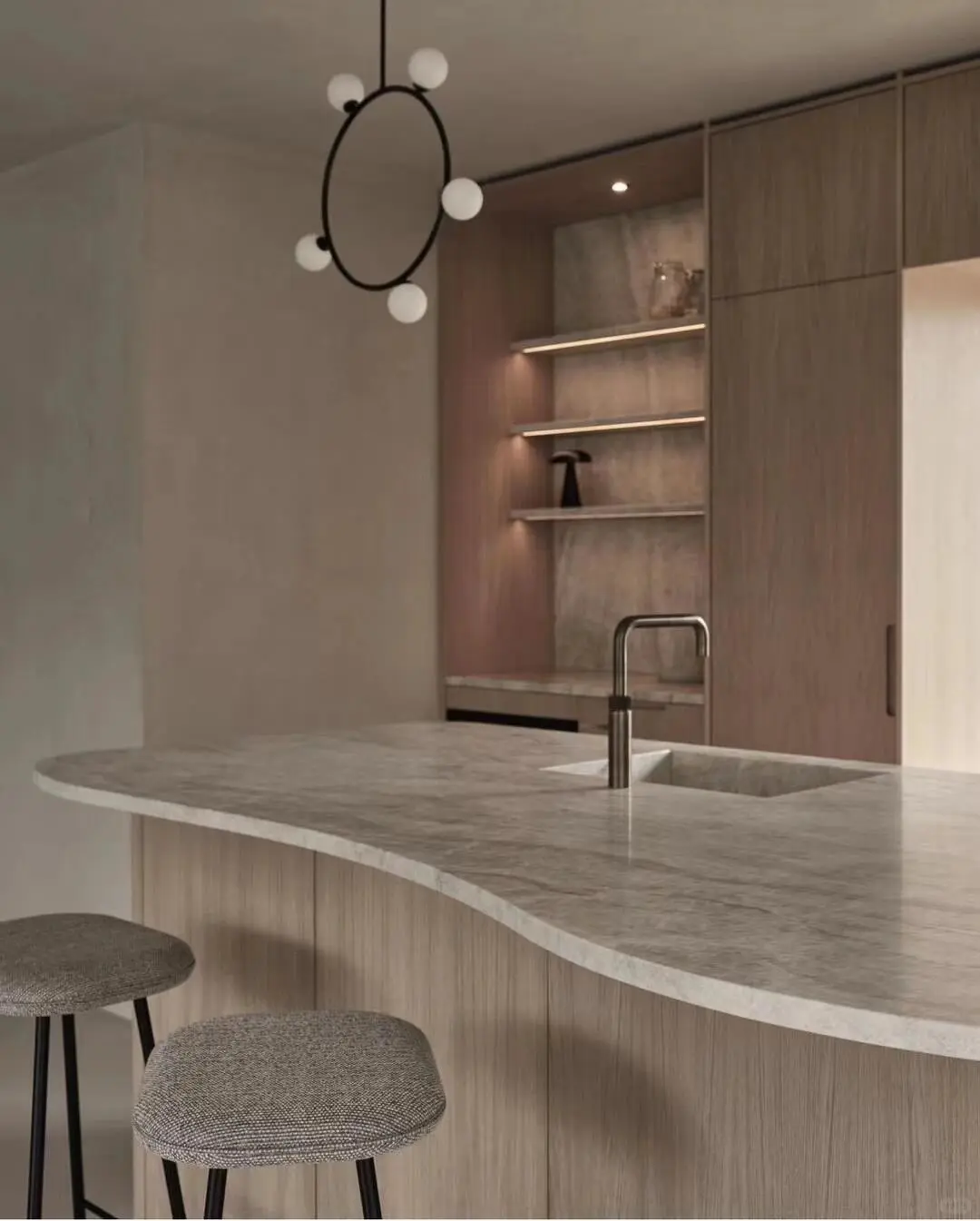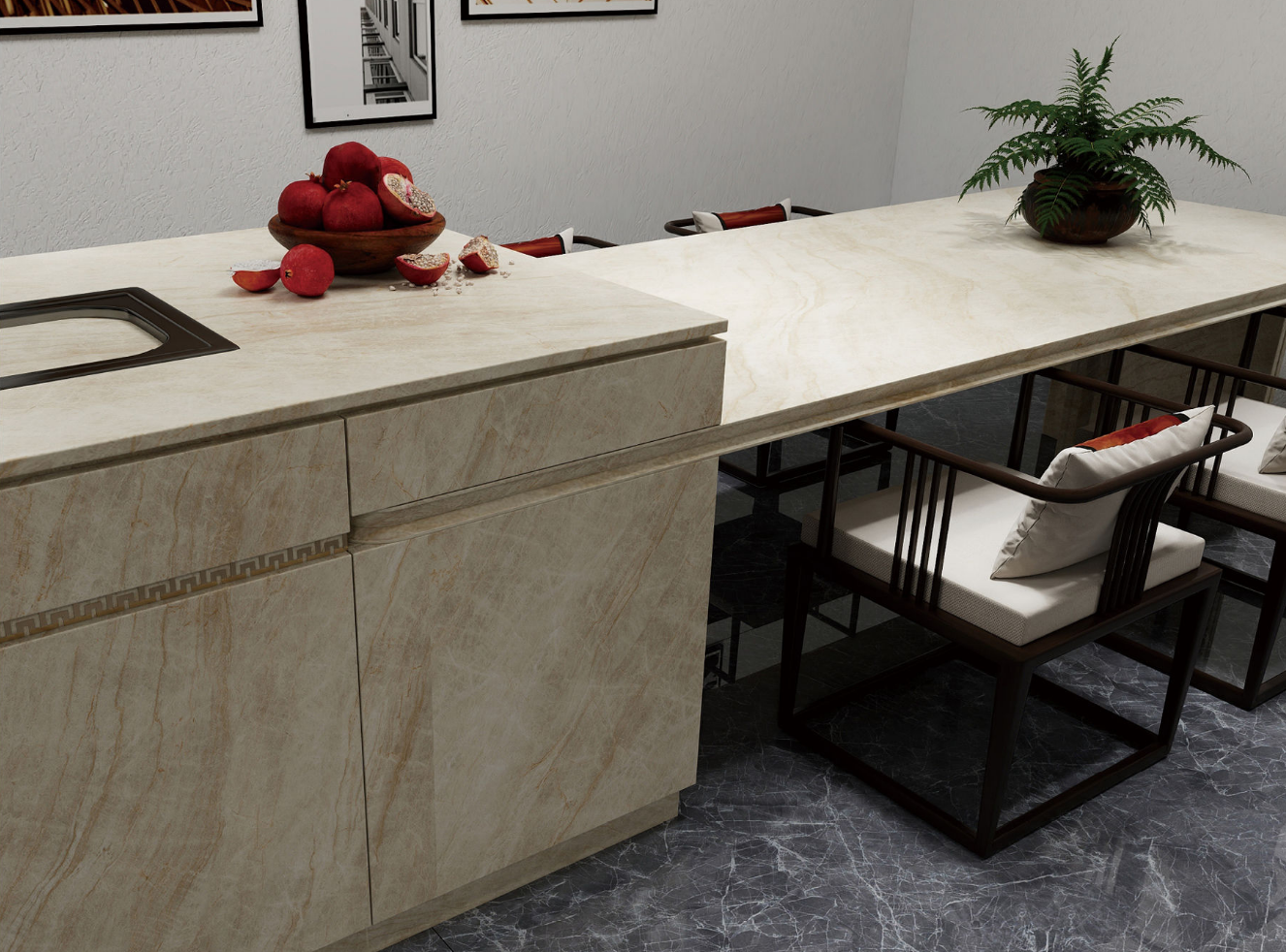Otključajte ljepotu radnog pulta Taj Mahal: Praktični vodič za vlasnike kuća
Radni pult Taj Mahal postao je omiljen među vlasnicima kuća koji žele dodati eleganciju i toplinu svojim kuhinjama i kupaonicama. Ime je dobila po sličnosti s ikoničnim mramorom indijskog Taj Mahala, ovaj prirodni kameni radni pult uspješno miksira vječitu ljepotu s praktičnom izdržljivošću. Bez obzira na to da li obustrojavate kuhinju ili nadograđujete radni pult u kupaonici, razumijevanje svojstava Radni pult Taj Mahal koja ga čine jedinstvenim, kako za njega brinuti i kako ga uključiti u svoj dom, pomoći će vam da maksimalno iskoristite ovaj spektakularan materijal. Ovaj vodič objašnjava sve što trebate znati kako biste otkrili njegov potpuniji potencijal.
Što je radni pult Taj Mahal?
Taj Mahal Countertop je vrsta prirodnog vapnenca, koji se uglavnom iskopava u Brazilu. Za razliku od poliranog mramora ili granita, ima mekani, kremasti osnovni ton s diskretnim zlatnim, bež i sivim žilama koje imitiraju izgled starog mramora – bez visokih zahtjeva u održavanju. Njegova tekstura je nešto porozna, ali gušća od mnogih drugih vapnenaca, što ga čini otpornijim na ogrebotine i mrlje kada je pravilno zapečaćen.
Ono što Taj Mahal Countertop ističe je njegova svestranost. Topli, neutralni tonovi prilagođavaju se širokom spektru dizajnerskih stilova, od modernog do tradicionalnog, a njegove prirodne varijacije osiguravaju da dvije ploče nikada nisu potpuno identične. Ova jedinstvenost dodaje karakter svakom prostoru, čineći ga fokalnom točkom bez prevelikog utjecaja na ambijent.
Zašto odabrati Taj Mahal Countertop za svoj dom?
Vlasnici domova vole Taj Mahal Countertop zbog miksiranja ljepote i praktičnosti. Evo zašto bi to mogao biti pravi izbor za vaš projekt:
- Vječna estetika : Kremasta baza i meke žilice daju klasičan izgled koji nikada ne izlazi iz mode. Udobro se slaže s bijelim ormarićima za svijetlu, prozračnu kuhinju ili s tamnim drvetom za bogat, kontrastan osjećaj.
- Izdržljivost : Kao gusta vapnenčana stijena, dobro izdržava svakodnevno korištenje. Manje je sklono oštećenjima od mramora i može izdržati vruće lonce (iako se preporučuje korištenje podmetača).
- Svestranost : Koristi se u kuhinjama (otoci, radne plohe), kupaonicama (umivaonici, obloge za tuš kadu) pa čak i u vanjskim prostorima (zatvoreni terasi) u blagim klimama.
- Vrijednost : Iako je prirodni kamen, radna ploha Taj Mahal često je jeftinija od rijetkih mramora poput Calacatte, što je proračunska opcija za elegantan izgled.
Za obitelji, praktičan je izbor – njezina neutralna boja bolje skriva manje ogrebotine u usporedbi s bijelim mramorom, a odgovarajuće impregnacije čine je otpornom na prolivenosti.
Razumijevanje izgleda: Boje i uzorci
Izgled radne plohe Taj Mahal je njezin najveći magnet za pažnju. Hajde da razložimo njezine ključne vizualne značajke:
- Boja osnove : Topla krem ili mek bež koji varira od gotovo bijele do tamnije pijeskovite nijanse. Ova neutralna baza olakšava usklađivanje s bojama zida, ormarićima i dekoracijom.
- Žilave : Tanke do srednje žile u zlatnoj, svijetlo smeđoj ili sivoj boji. Ove žile su manje izražene u odnosu na one kod granita, čime se postiže suptilniji i elegantniji izgled kamena. Neki ploči imaju peraste uzorke, dok drugi imaju nitaste linije koje se protežu po površini.
- Mogućnosti završetka : Obično se prodaje u poliranom izdanju, što naglašava prirodni sjaj kamena i ističe žilavost. Dostupna je i brušena (mat) površina za više rustikalni i jednostavniji izgled, iako može prikazati otiske prstiju.
Kada birate ploču, posjetite skladište kamena i odaberite je osobno – fotografije ne mogu prikazati jedinstvene varijacije. Potražite ploču čije žilavost harmonira s vašim prostorom: na primjer, duže žile izgledaju dobro na velikom kuhinjskom otoku, dok sitniji uzorci odgovaraju manjim radnim površinama.

Kako instalirati radnu ploču Taj Mahal
Ugradnja radnog stola Taj Mahal zahtijeva pažljivo planiranje kako bi se osigurala savršena prilagodba i trajnost. Evo što vlasnici kuća moraju znati:
- Točno izmjerite : Angažirajte stručnjaka za izmjere prostora, uključujući prepuste (obično 1–1,5 inča za radne stolove, 10–12 inča za rubove otoka). Točne izmjere sprječavaju pukotine i nejednake rubove.
- Odaberite kvalificiranog instalatera : Ugradnja prirodnog kamena nije projekt za samogradnju. Potražite instalatere s iskustvom u radu s vapnencom – znat će kako rukovati pločom kako bi se izbjegle pukotine i osigurala pravilna podrška.
- Pripremite ormariće : Ormarići moraju biti čvrsti kako bi izdržali težinu kamena (radni stol Taj Mahal teži oko 15–20 funti po četvornom stopalu). Instalateri mogu dodati ivericu kako bi ojačali slabije točke.
- Zaštitite prije uporabe : Većina instalatera nanosi zaštitni premaz nakon ugradnje kako bi spriječila mrlje na kamenu. Pitajte koji tip premaza koriste (vodeni premazi prijateljski su prema okolišu i lako se ponovno nanose).
Ugradnja traje 1–2 dana za standardnu kuhinju. Obavezno planirajte vrijeme kada nećete koristiti radnu plohu 24 sata kako bi brtvilo stvrdnulo.
Savjeti za održavanje radne plohe Taj Mahal kao nove
Uz odgovarajuće održavanje, radna ploha Taj Mahal može ostati lijepa desetljećima. Slijedite ove jednostavne korake:
- Dnevno čišćenje : Odmah uklonite proliveno mekom krpom i toplom vodom s sapunom. Izbjegavajte kisela sredstva za čišćenje (poput octa ili limuna) jer mogu izazvati oštećenja površine, ostavljajući matne mrlje.
- Redovno brtvljenje : Ponovno brtvite radnu plohu svakih 6–12 mjeseci (češće u područjima s velikim opterećenjem poput kuhinje). Kako biste provjerili treba li ponovno brtviti, kapnite malo vode na površinu – ako se voda skuplja u kuglice, brtvilo još uvijek djeluje; ako upije vodu, došlo je vrijeme za ponovno brtvljenje.
- Zaštita od topline i ogrebotina : Koristite podloške ispod vrućih posuda, rezne daske za rezanje i podstavice za čaše. Iako je vapnenac izdržljiv, oštri noževi ili snažni udari mogu izazvati oštećenja.
- Pažljivo uklanjanje mrlja : Za maseća mrlja (poput biljnih ulja), napravite pašu od sode bikarbone i vode, nanesite na mrlju i ostavite preko noći prije nego što obrišete. Za organske mrlje (poput kave), koristite vodikov peroksid pomiješan s nekoliko kapi amonijaka (prvo testirajte na skrivenom mjestu).
Izbjegavajte uporabu abrazivnih čistidba ili čistih spužvica – mogu ogrebsti površinu i učiniti kamen osjetljivijim na mrlje.
Ideje dizajna: Kombiniranje Taj Mahal radne plohe s vašim stilom kuće
Neutralna paleta Taj Mahal radne plohe olakšava uklapanje u bilo koji dizajn. Evo nekoliko ideja za različite stilove:
- Moderne kuhinje : Kombinirajte s bijelim ili svijetlo sivim ormarićima u shaker stilu, nehrđajućim čeličnim uređajima i zlatnom opremom. Topli žilavi tonovi kamena dodaju toplinu glatkim, čistim linijama modernog dizajna.
- Tradicionalni domovi : Kombinirajte s tamnim drvenim ormarićima (poput trešnjeve ili orahove) i brončanim elementima. Kontrast između kremkastog kamena i bogatog drva stvara klasičan, gostoljubiv izgled.
- Obalni prostori : Kombinirajte s ormarićima od valovite ploče, mekim plavim zidovima i detaljima od užeta. Svetla boja kamena podsjeća na pješčanu obalu, pojačavajući pomorski stil.
- Industrijski stilovi : Kombinirajte s ormarićima od crnog metala, betonskim podovima i izloženom opekom. Kamen ublažava oštrinu industrijskih materijala, dodajući ravnotežu.
Za kupaonice, koristite Taj Mahal radnu plohu na ormarićima s bijelim keramičkim pločicama ili staklenim vratima tuš kabine. Također se može koristiti kao ploča iza umivaonika ako se izreže u manje pločice, stvarajući usklađen izgled.
Usporedba cijena: Je li Taj Mahal radna ploha prikladna za vaš budžet?
Taj Mahal radna ploha spada u srednju klasu prirodnog kamena. Usporedba cijena:
- Cijena po četvornom metru : 60–90 USD, uključujući materijal i ugradnju. Jeftinija je od Calacatta mramora (150–200 USD), ali skuplja od laminata (20–50 USD) ili kvartza (50–80 USD).
- Dugoročni troškovi : Iako su početni troškovi veći u odnosu na sintetske materijale, njegova trajnost znači da ga nećete morati često mijenjati. Sredstva za impregnaciju su jeftina (oko 20–30 dolara po boci), što dodaje minimalne stalne troškove.
Za vlasnike kuća koji planiraju dugo ostati u svojoj kući, ulaganje je isplativo – radna površina Taj Mahal može povećati prodajnu vrijednost poboljšavanjem atraktivnosti kuhinje ili kupaonice.
Česta pitanja
Je li radna površina Taj Mahal prikladna za vrlo korištenje u gužvi kuhinje?
Da. Njegova gusta vapnena struktura izdržava svakodnevno korištenje, a odgovarajuća impregnacija sprječava većinu mrlja. Bolji je izbor od mramora za obitelji s djecom ili one koje često kuhaju.
Kako se razlikuje od mramora?
Radna površina Taj Mahal je od vapnenca, koji je gušći i manje porozan od mramora. Otporniji je na ogrebotine i mrlje, iako i dalje zahtijeva impregnaciju. Mramor ima izraženije žile, ali je mekši i skloniji oštećenjima.
Može li se koristiti na otvorenom?
Funkcionira u zatvorenim vanjskim prostorima (kao što su terase s krovom) u umerenim klimama. Izbjegavajte izravnu kišu ili smrzavanje, jer upijanje vode može uzrokovati pukotine u hladnim vremenima.
Kako ukloniti mrlje od kiseline?
Mrlje od kiseline mogu se ukloniti brušenjem pomoću polirnog sredstva za kamene površine (dostupno u trgovinama s materijalom za popravke). Za duboke mrlje, angažirajte stručnjaka za obnovu kamena.
Je li boja nestabilna na suncu?
Ne, njezina boja je stabilna i neće izblijediti od izloženosti suncu, što je čini prikladnom za kupaonice s velikim prozorima ili kuhinje s prozorima na krovu.
Sadržaj
- Što je radni pult Taj Mahal?
- Zašto odabrati Taj Mahal Countertop za svoj dom?
- Razumijevanje izgleda: Boje i uzorci
- Kako instalirati radnu ploču Taj Mahal
- Savjeti za održavanje radne plohe Taj Mahal kao nove
- Ideje dizajna: Kombiniranje Taj Mahal radne plohe s vašim stilom kuće
- Usporedba cijena: Je li Taj Mahal radna ploha prikladna za vaš budžet?
- Česta pitanja

